WHITE PAPER ON TRAFFIC SAFETY IN JAPAN 2006
- Japanese
- English
Back to previous page (we2006-1.html).
{3} In 2006, through the Ministry of Foreign Affairs, the Cabinet Office surveyed development rates for sidewalks in other countries to see how Japan compared internationally. Among OECD member countries, data on sidewalk development was available only in Japan and four other countries. Because of differences in methods of calculating the length of sidewalks added and because of different road environments in each country, no simple comparison could be made. Still, differences in rates of sidewalk development emerged among the countries surveyed.
| Development rates for sidewalks | Remarks | |
|---|---|---|
| Japan | 13.2% |
(1) As of April 1, 2004
(2) Excludes national expressways
(3) Development rate: length of roads along which sidewalks have been constructed /length of roads. When sidewalks are built on both sides of a road, only the fact that a sidewalk has been constructed on one side of the road is considered in the calculation.
|
| UK | 93.0% |
(1) The figure for total length of roads is as of April 30, 2004. The total length of sidewalks is calculated from average figures for the period 2002-2004.
(2) Calculated only for England and Wales.
(3) Excludes motorways and trunk roads.
(4) When sidewalks are built on both sides of a road, each sidewalk is considered independently and the accumulated lengths of these sidewalks are used in calculations of development rates.
|
| Norway | 14% |
(1) As of the end of 2004.
(2) Total for national, prefectural and municipal roads. Development rates for prefectural and municipal roads are based on estimates of sidewalk development.
|
| Finland | 6.0% |
(1) As of the end of 2004.
(2) Only for roads managed by the national government (excluding expressways).
(3) The sidewalk development rate for roads managed by the city of Helsinki is approximately 140% (when sidewalks are built on both sides of a road, each sidewalk is considered independently and the accumulated lengths of these sidewalks are used in calculations of development rates).
|
| Korea | 3.7% |
(1) As of the end of 2004.
(2) Only for national roads.
|
{4} In its “2001 Survey on Roads,” the Cabinet Office asked respondents “From the standpoint of road improvement, what kinds of measures do you believe are necessary to enhance road safety?” The most widely cited responses were “the development of pedestrian-only roads” (39.0%) and “the development of wider sidewalks” (31.7%).
Measures for the Enhancement of Road Safety (multiple responses)
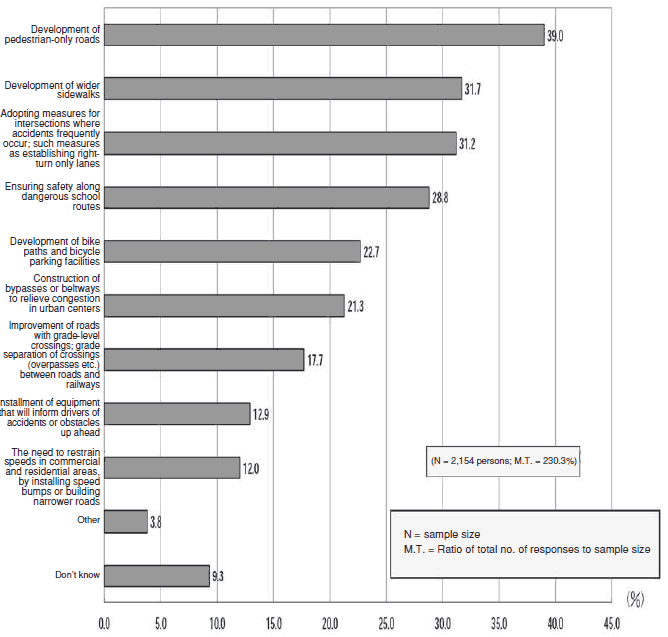
Notes: |
Source: Cabinet Office |
|---|
2 Toward Developing People-First Walking Spaces that Ensure Safety and Bestow Peace of Mind
Most of the traffic safety measures that have been successful to date have dealt primarily with the automobile. The nation is still not paying sufficient attention to road development and traffic safety projects that will benefit the pedestrian.
Moreover, the safety of children commuting to school remains at serious risk from traffic detouring through near-by residential roads to avoid congestion on the major thoroughfares. As birthrates continue to fall and the elderly become a larger part of the population hereafter, there is a need not only to reduce fatalities among the elderly, whose deaths constitute 40% of all traffic deaths, but also to protect children who are the nation's future.
In light of this situation, the nation continues to adopt traffic safety measures that focus on the development of walking spaces that ensure safety and peace of mind to pedestrians. Guided by a people-first philosophy, these policies urge more active policy initiatives aimed at developing sidewalks and other facilities along school routes, residential roads, and major thoroughfares through urban districts, in cooperation with local communities.
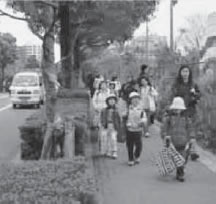
Safe commutes to schools
(1) Promoting the development of sidewalks etc. along school routes and other roads
To ensure the safety of young children commuting to elementary schools, kindergartens, day care centers, and children's cultural facilities, the nation will advance an ambitious program for the development of sidewalks etc. along school routes.
These measures will include projects to install push-button activated traffic signals and pedestrians walk signals, to construct pedestrian overpasses, and to build more crosswalks.
(2) Promoting traffic safety measures along residential roads
In FY2003, the nation identified 796 locations in residential and commercial districts as sites requiring emergency measures to ensure safe use by pedestrians and bicycle riders. Known as “Safe Pedestrian Areas,” these became the focus of sidewalk building programs and other areawide and comprehensive accident prevention measures that were carried out in cooperation with prefectural public safety commissions and road management agencies. In addition to continuing to identify and improve other Safe Pedestrian Areas hereafter, the nation will actively promote projects to install sidewalks at sites along residential roads that are located outside these designated areas. Through use of an “Accident Prevention Manual for Residential Roads,”8 the traffic safety agencies involved will vigorously promote the adoption of other improvements to the road traffic environment that contribute to the reduction of traffic accidents.
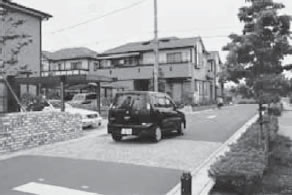
Speed bump in residential area
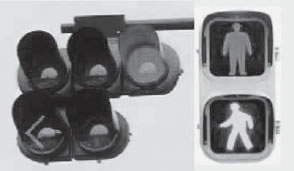
LED traffic signals
(3) Provision of barrier free and other walk spaces
{1} To ensure safety and comfort for pedestrians and bicycle riders, the nation will adopt a two-pronged approach toward improving locations that are particularly prone to pedestrian accidents: carry out redesign projects; and continue to focus on the development of sidewalks and bike paths. In these improvement projects, the nation will endeavor to build sidewalks that are wide enough to permit comfortable passage by users. In instances where it is impossible to build sidewalks or other pedestrian facilities along existing roads, those involved will substitute exclusive pedestrian roads or combination bicycle and pedestrian paths that run parallel to the existing road.
{2} In order to help seniors and disabled people lead independent, socially active lives, the nation will pursue ambitious programs of sidewalk building in areas near train stations, public facilities, welfare facilities, hospitals and so on, basing their plans on universal design concepts, which ensure sufficient width and evenness. The nation will also endeavor to make improvements in the following areas: in the installation of barrier-free traffic signals (with audio assistance); in signals that indicate waiting time at crosswalks; in the construction of pedestrian overpasses equipped with lifts; in rest areas for pedestrians; in bicycle parking facilities; and in the design of parking facilities with enlarged parking stalls, which accommodate the needs of the disabled. The nation will also endeavor to eliminate utility poles as part of their renovation projects, convert traffic signals to LED lighting, and enhance road signs and markings to make them more visible to elderly motorists.

Wide sidewalks
8See footnote 5.
- Traffic safety education for the elderly
- The nation also recognized the need to increase traffic safety awareness of seniors themselves, through mutual edification programs involving seniors. Toward this end, the country supported the establishment of traffic safety clubs within senior's clubs and retirement homes and encouraged the training of “Silver Leaders,” seniors who provide education on traffic safety to other seniors. It also encouraged seniors' clubs to take leadership roles on traffic safety within their communities and households, and provided support for such efforts. In conjunction with related organizations, seniors' clubs responded by preparing “Hiyari Maps” (maps of near-miss spots) and by proposing and organizing seminars on the safe use of electric wheelchairs (wheelchairs powered by motors that meet standards set by the Enforcement Regulations of the Road Traffic Law), whose use has begun spreading rapidly in recent days.
- The Cabinet Office carried out two programs in the area of traffic safety education for the elderly. One, called the “Citizen-involved Project to Promote Traffic Safety Education for Seniors,” aimed to train leaders who would continue to promote programs of traffic safety education based on participation, hands-on experience, and actual practice. The other, called the “Central Training Program for Silver Leaders,” sought to improve Silver Leaders' ability to educate sub-leaders. The Cabinet Office also continued its efforts in the “Traffic Safety Awareness Program for Seniors,” which encompasses the “Cross-generation Sharing Project,” in which people from three generations gather to learn about traffic safety, and the “Seniors Home Visit Project,” in which traffic safety guidance is provided at home to seniors unable to attend traffic safety seminars.
Reflective Material and Traffic Safety
In 2005, fatalities from traffic accidents declined for the fifth consecutive year, and they fell below 7,000 for the first time in 49 years (since 1956). Fatalities among pedestrians remained high, however, reaching 2,104 and accounting for more than 30% of all traffic-related deaths. Of these, approximately 70% occurred while people were walking at night. Moreover, the fatality rate of casualties at night was around 3.8 times that of casualties during the day.
Given this situation, achieving the government's goal of “reducing traffic fatalities to less than 5,000 within a 10-year period” will depend significantly on being able to reduce the number of pedestrian deaths at night.
On the other hand, although reflective material is widely recognized as an effective means of preventing traffic accidents at night, the number of people who own or use such material is low. Taking this situation into account, the national government has been endeavoring to prevent nighttime accidents by stepping up its calls to pedestrians to use reflective material as a means of improving their visibility to drivers.
In this section, we detail the activities engaged in by the National Police Agency and the prefectural police departments to improve traffic safety, primarily their coordinated campaign to encourage the use of reflective material during FY2005.
Pedestrian fatalities during the day and at night during 2005
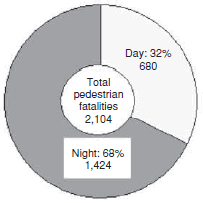
Note: |
Source: National Police Agency |
|---|
Survey results on awareness, ownership, and use of reflective material by pedestrians

Cabinet Office: |
Special Survey on Traffic Safety (December 2004) |
|---|
Reflective material employs a property called retroflection, in which the material isoptically designed to reflect light back in the direction of the light source, no matter what itsdirection. Light from a car's headlights, when shined on a reflective material, will bereturned in the direction of the car, which is the source of the light. When this happens, thereflective material will appear very bright to the driver, who will thus recognize thepresence of a pedestrian from a long distance away.
2 Campaigns by the National Police Agency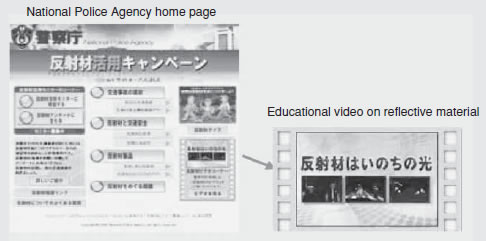
In conjunction with awareness-raising activity by prefectural police departments, the National Police Agency took steps to expand the campaign to promote reflective material to a national audience. To publicize its efforts, the agency produced an educational video and established a home page on reflective material, which it maintained between September 2005 and January 2006.
-
(1) Number of persons accessing home page:
Number of persons accessing home page: approximately 67,000 (an average of 438 persons/day)
Number of persons viewing National Police Agency video (“Reflective Material: the Lifesaving Light”): approximately 5,400 persons
-
(2) Survey results on effects of using reflective material Through its home page, the National Police Agency assembled a group of persons to act as monitors and on three separate occasions asked them to respond to surveys regarding the effects of wearing reflective material during their walks.
- {1} Persons who wore reflective material each time he or she left the house at night
...increased from 23% to 35% - {2} Persons who felt a resistance to using reflective material
...decreased from 20% to 5% - {3} Persons who directly sensed the impact of using reflective material, including feeling that “approaching cars slowed down upon seeing them”
...39% - {4} Drivers who confirmed an increase in visibility when pedestrians wore reflective material:
...99% - {5} Persons who will continue to wear reflective material hereafter
...80% - {6} The principal reflective materials used by monitors
-
(1) Prefectural citizens campaigns
Using easily identifiable names such as the Safe Night Initiative, the Aurora Initiative and the “Ashi Pika” (flashing feet) Movement, prefectural police engaged in a variety of activities aimed at generating momentum for wider use of reflective material among prefectural residents. They distributed reflective material on street corners, on visits to seniors' homes, and at lectures and other educational events. They also placed them directly on to shoes etc., used by people in their everyday lives at these events.
-
(2) Street campaigns, with participation by governors and local administrative heads
The police mobilized large numbers of volunteers from local governments and related agencies and organizations to distribute leaflets and other information at major intersections and at shopping and entertainment districts. At these events, participants wearing reflective garments encouraged passersby to use reflective material.
-
(3) Convening of nighttime educational programs
These were nighttime programs oriented toward participation, hands-on experience, and actual practice which sought to increase the public's understanding of the benefits of wearing reflective material, ways of wearing the material, etc. The police used cars at driver training facilities, schools and other locations to demonstrate a number of phenomena, including: 1) differences in visibility depending on the color of clothing worn and whether a pedestrian was or was not wearing reflective material; 2) the areas that are visible to drivers within their headlights beams; 3) the glare phenomenon caused by light from an approaching vehicle which causes objects to disappear.
-
(4) Fashion shows highlighting reflective material
The items put on display at these shows included shoes with built-in reflective material, and clothing and accessories such as jackets, coats, hats, umbrellas and handbags that incorporate reflective material into their design. The shows also demonstrated the variety and the benefits of reflective material by introducing novel applications such as reflective sashes, shoes with reflective seals attached, reflective key holders, and other products.
To foster a greater sense of familiarity with the material, the police also staged tee-shirt competitions in which all entries incorporated reflective material into their designs.
-
(5) Delegation of promotional activities
Under this program, municipal heads of government and police chiefs delegated authority to promote reflective material to outside groups, principally community seniors' groups, which were designated as task forces for the wider use of reflective material. In addition to leading by example, these groups organized events where they urged people in the community to use reflective material.
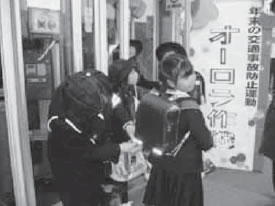
The police program urging the community to use reflective patches
-
(1) Promoting experience-based traffic safety education
One of the findings of the campaign by the prefectural police was not unexpected: that monitors who experienced the benefits of using reflective material generally continued to use the material.
In view of this success, the nation will continue to promote hands-on traffic safety educational programs that enable participants to experience the benefits of reflective material and that promote a correct understanding of these benefits.
-
(2) Encouraging a wider dissemination of reflective clothing and other products that are used on a daily basis
To encourage wider acceptance of the idea of wearing reflective material on a regular basis, one effective approach is to incorporate the material unobtrusively into clothing and daily accessories. This has led the National Police Agency to encourage industry to develop and distribute a wide variety of reflective products by providing support for activities of the Committee to Promote the Utilization of Reflective Material, which comprises representatives of related industries and organizations.
- Developing better and more effective measures for elderly drivers
- Programs for evaluating the competency of senior drivers, which are required for persons over the age of 70, include tests for competencies that are necessary for safe driving. In these programs, participants may be asked either to drive a vehicle or to use driver-competence testing equipment to arrive at evaluations. The goal is to have elderly drivers become aware of the changes that are occurring in their physical functioning and to offer advice and guidance based on the results of the findings. Under existing regulations, persons who participate in these programs are not required to take courses that they normally would be required to upon renewing their licenses. In 2005, a total of 1,558,095 persons participated in these programs. Traffic safety agencies also organized classes for drivers between 65 and 70 years of age, which are held in conjunction with license renewals. These classes endeavored to teach seniors about their own driving tendencies and about the characteristics of accidents in which the elderly were commonly involved.
- Improving and strengthening the recall system
- To prevent the recurrence of fraudulent activity surrounding recalls, the nation took the following steps. First, the nation strengthened the information gathering system for automobile defects by publicizing to drivers the availability of the automobile defect hotline and requiring the manufactures to issue regular reports on the problems that were arising, and so forth. Second, the nation strengthened its auditing capabilities to permit priority auditing of suspicious manufacturers and to make more resources available for dealer audits. Third, related agencies expanded and improved their technical inspection capabilities by increasing the number of professional recall evaluation personnel (who are experts on automobile technology), by establishing recall inspection and investigation committees, and so forth.
- Enhancing the effectiveness of the doctors-on-helicopters program
- The doctors-on-helicopters program, which uses specially equipped emergency helicopters and deploys to emergency sites with a physician on board, got started with the aim of providing better medical care at emergency sites and during patient transportation. The helicopters enable the medical care to commence earlier and patients to be transferred more rapidly to hospitals. As of the end of FY2005, ten emergency stations in nine prefectures operated such helicopters. Operationally, through enhanced coordination among related agencies and groups, the nation made progress on several fronts in this program, including in the sharing of information on zones and locations where helicopters can safely land, in the preparation of an “Operational Manual,” and in the development of a common-frequency radio system.
(1) Railway operations accidents have been in a long-term decline, but in 2005 increased to 905, 15.7% above the level of the previous year.
(2) In 2005, casualties from railway operations accidents numbered 1,358 (including 474 fatalities), a 104.8% increase.
(3) Accidents at railway crossings increased by 20.6% to 450, of which operations accidents accounted for roughly one half. Casualties from these accidents numbered 306, which was 20.0% higher than the previous year.
(4) There were four major accidents in 2005, all derailments: on the Tosa-Kuroshio Sukumo Line on March 2; on the JR West Fukuchiyama Line on April 25; on the Hiroshima Electric Railway Company's Ujina Line on October 14; and on the JR East Uetsu Line on December 25.
9 Operations accidents
Refers to train collisions, derailments, train fires, accidents at rail crossing, accidents along other roads, accidents that result in injury or death to persons (other than from the foregoing five types of accidents), and accidents that result in material damage to property (other than from the foregoing six types of accidents). Street rail accidents are defined in the same manner as railway operations accidents.
Changes in Railway Operational Accidents and Casualties
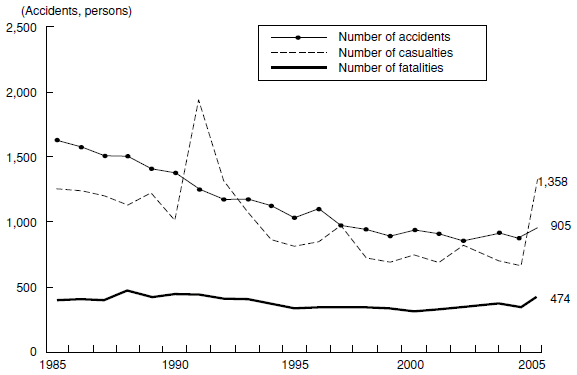
Notes: |
1. | Source: Ministry of Land, Infrastructure and Transport |
|---|---|---|
| 2. | Fatalities are defined as deaths occurring within 24 hours of an accident. |
Future Directions in Railway Transportation Safety Measures
- From the Eighth Fundamental Traffic Safety Program - 1 Basic Thinking
Railways are an indispensable part of the daily life of the nation because of their ability to transport large numbers of people and large quantities of freight rapidly and on time. Given the high-density use of railways today, a single accident will not only severely disrupt the benefits enjoyed by their users but can also cause enormous damage. The nation, therefore, needs to advance various safety measures and to establish an unshakeable trust among the people in the reliability of its railroads.
2 Objectives- Aim to reduce the number of passenger deaths to zero.
- Aim to reduce the number of operations accidents.
To solve the problems that lie behind individual accidents and to implement effective measures that profit from the lessons of past accidents, the nation must advance measures that deal comprehensively with such issues as improving the railway traffic environment, assuring safe operations of railways, and enhancing the safety of train cars.

Automatic train stop (ATS) device
-
{1} Improving the railway traffic environment To ensure the safety of railroad traffic, railway operators must maintain their tracks, safety equipment, and other facilities in highly reliable working order, and make this the foundation of safety for their overall systems. Achieving this will require not only a strict adherence to programs of facilities upkeep and maintenance but also the implementation of policies aimed at upgrading operational safety devices and strengthening the earthquake resistance of railway structures.
-
{2} Assuring the safe operations of railways
The nation will encourage the building of safety management systems in which everyone, from top management to operational personnel, works as a team. Regulatory agencies will also adopt the mechanisms of the “Management Safety Evaluation System,” under which the national government confirms the adequacy of these safety management systems.
Regulatory agencies will also require railways to maintain and enhance the quality of their train crews and safety specialists, and will promote the development of stronger and wider ranging safety audits. They will also endeavor to heighten the public's awareness of safety-related issues through public information activities directed to the nation as a whole.
-
{3} Enhancing the safety of train cars
Weighing the progress being made in scientific and technical areas, the nation will take steps to maintain and improve the safety of its train cars. It will do so by reassessing, in a timely and appropriate manner, safety-related technical standards for the structure of rail cars and the equipment used in them, and by urging the adoption of more effective methods and programs of inspection.
-
{4} Improving rescue and emergency services systems
When a major railway accident occurs, crews must be promptly and unerringly mobilized to care for evacuation, rescue and emergency medical needs. To prepare for these situations, regulatory agencies will carry out increasingly comprehensive disaster drills at major train stations and strengthen systems of coordination and cooperation between railway companies and the agencies that will be coming to assist them: fire departments, medical institutions and others.
-
{5} Promoting measures for the support of victims
The nation will strengthen its support of victims who are seeking compensation for losses, and will promote measures that are sensitive to the psychological and spiritual needs of victims. Particularly in the event of catastrophic accidents, the police, medical institutions, local governments, and private victims-support organizations will act in concert to support victims.
-
{6} Improving capabilities in research and development and investigation and analysis In addition to supporting further research and development into ways of preventing railway accidents, the nation will advance measures that support programs of comprehensive investigation and analysis into the causes of accidents. everyone, from top management to operational personnel, works as a team. Regulatory agencies will also adopt the mechanisms of the “Management Safety Evaluation System,” under which the national government confirms the adequacy of these safety management systems.
- Upgrading operational safety devices
- Trains are being operated at increasingly higher speeds, on increasingly crowded tracks. To ensure the safety of train operations under such conditions, the nation will promote the improvement of centralized traffic control devices (CTC). Also, based on a plan for emergency improvements that was adopted in the wake of the JR West Fukuchiyama Line derailment, regulators have directed railway companies to complete the installation of ATS devices (automatic train stop) which prevent trains from traveling above allowable speeds on sharply curving sections of tracks. The deadline for the completion of this work has been set at 2009.
- Strengthening the earthquake resistance of railway structures
- Based on evaluations made by the “Conference on Shinkansen Derailment Countermeasures,” the nation implemented measures to strengthen tunnels where reinforcement against earthquakes became necessary following the confirmation of active faults along their routes. The nation also adopted measures to strengthen the earthquake resistance of pillars that are supporting elevated tracks. The problematic pillars have been weakened by above-ground concrete laid near their midway points. The nation also took steps to strengthen pillars for elevated tracks along other sections of the bullet train route and along older commuter and express lines.
- Improving educational programs for trains crews and safety specialists; enhancing the basic competence of personnel
- To ensure that those seeking to operate power cars (hereinafter, “train operators”) have the temperament and other qualities to perform the job competently, the nation implemented a system of exams for train operators. It also convened an evaluation committee that examined the issue of how to enhance the competence of train operators. This committee looked into various methods of educating train operators and of improving their occupational environment.
- Improving the management of train operations and crews
- In the area of traffic control systems, regulators directed railway companies to take steps to establish rapid and efficient driver command systems. These steps included increasing the number of radios available for operational commands and intra-crew communications, and introducing centralized traffic control (CTC) devices. In terms of personnel management, regulators directed railway companies to foster a greater awareness of the importance of safety among their employees. They also directed train companies to improve their systems of safety management by establishing procedures that enable them to closely monitor the psychological and physical condition of their crews at the time they begin work.to enable the crews to perform their jobs competently and to ensure safe driving.
Accident Investigation and Safety Measures Relating to the Derailment Accident on the JR West Fukuchiyama Line
On April 25, 2005, the first five cars of a train traveling on a curved section of the track between Tsukaguchi Station and Amagasaki Station on the JR West Fukuchiyama Line derailed, catapulting the first two cars into a condominium on the left side of the tracks. This catastrophic accident resulted in 107 deaths and 549 injuries (as reported by the Emergency and Rescue Section of the Fire and Disaster Management Agency at 9:00 a.m., May 24). Currently, members of the Aircraft and Railway Accidents Investigation Commission (ARAIC) are working diligently to uncover the causes of the accident. An outline of the course of the investigation to date, and of the safety measures adopted as a result, is as follows.
1 Accident investigationOn April 25, ARAIC sent two commissioners and five railroad accident investigators to the accident site. From then until August 31, the commission chairman, ARAIC commissioners, and commission experts spent a total of 30 man-days at the site; the bureau chief and railroad accident investigators spent another 256 man-days there. Recognizing the urgency of considering measures that would prevent the reoccurrence of such accidents, ARAIC issued an interim report on its investigations on September 6 and made a number of recommendations to the Minister of the Ministry of Land, Infrastructure and Transport (MLIT). Its recommendations touched on such issues as enhancing the performance of ATS devices, making sure that other trains are protected from secondary damage at the time of such accidents, installing and using devices that record the condition of trains on the tracks, and enhancing the precision of speed sensors. The commission is currently continuing its investigations with the aim of arriving at its final conclusions on the causes of the accident.
2 Safety measuresFollowing the accident, MLIT instructed railway companies to complete installation of ATS and other devices which prevent trains from traveling at excess speeds around sharp curves on the track. The ministry also convened its Technical Standards Evaluation Committee to reassess the levels of safety required by current technical standards in light of accidents that have occurred in recent years. In November, the committee issued its interim findings, which proposed to the ministry that standards be set for the installation of speed control devices at curves and switches and at the end of tracks. Based on these recommendations, MLIT promulgated its revised technical standards on March 24, 2006.
Another important development in terms of safety measures was the passage on March 29, 2006 of the “Law to Amend the Railway Business Law to Enhance Transportation Safety.” The aim of the amendment was to establish systems of safety management within railway companies, including systems that deal with the fitness and suitability of train operators. In addition, MLIT convened an expert committee to look into the question of train operator suitability. This group, called the Committee to Evaluate Measures to Enhance Train Operator Fitness and Suitability, is examining ways of improving the education of train operators and of enhancing the work place environment.
MLIT also ordered JR West to formulate a Safety Improvement Plan that proposes radical measures aimed at preventing a reoccurrence of such accidents. Through audits of JR West's headquarters and branch offices, the ministry has been monitoring the company's efforts to implement the plan's proposals. On November 15, MLIT notified the company to continue working steadily on the plan. It is continuing to audit the company's performance and to issue guidance as necessary.
Expediting Measures to Eliminate Grade-Level Crossings
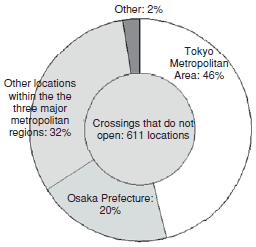
- The three major metropolitan areas encompass the TokyoMetropolitan Area and the following prefectures: Chiba, Saitama, Kanagawa; Aichi, Mie, Gifu, Osaka, Nara, Kyoto,and Hyogo
- Source: Ministry of Land, Infrastructure and Transport, 2004
Despite being in a long-term decline, accidents at rail crossings in Japan remain a problem. One such accident occurred on March 15, 2005, at a “rail crossing that does not open” near Takenotsuka Station on the Tobu Isesaki Line. Four people were injured, two fatally. Rail crossing accidents account for roughly half of all railway operationsaccidents, and many crossings still exist that require improvements.
There are approximately 36,000 grade-level train crossings in Japan, of which roughly 600 fall under the classification of “crossings that do not open.” This characterization refers to crossings where, during peak traffic hours, barriers remain down for over 40 minutes in a given one-hour period. Of these, 95% is concentrated within the metropolitan areas of Japan's three largest cities, Tokyo, Nagoya and Osaka.
MLIT has endeavored to replace grade-level crossings with overpasses or underpasses, and to carry out other structural improvements and to install new safety equipment. But to expedite work at sites where the need for improvement has reached a critical point, MLIT will adopt the following measures. By taking these and other steps to improve the safety and flow of traffic through level crossings, MLIT is aiming to reduce accidents at rail crossings in 2010 by 10% compared to 2005.
MLIT will conduct a comprehensive survey of conditions at all of the 36,000 rail crossings across the country. It carried out emergency evaluations at approximately 2,600 sites where the problems were deemed to be serious.
{Major items of evaluation}
Structure etc. of the grade-level crossings (width of road across tracks, width of pedestrian walkways across tracks, shape of track at crossing, etc.)
Traffic conditions (length of lines of cars waiting at crossings, the number of cars waiting in these lines, etc.)
(2) Establishing list of crossings requiring emergency improvements and formulating a 5-year improvement planBased on the results of the comprehensive survey, MLIT will determine which crossings fall under the category of “crossings that do not open” or “crossings with extremely narrow walking space” and require emergency renovations. MLIT will announce this list to the public. For crossings that require emergency action, MLIT will formulate 5-year improvement plans that take into consideration local needs.
(3) Emergency measures based on 5-year plansIn accordance with these 5-year plans, MLIT will take a comprehensive approach that encompasses both “measures that make immediate impacts,” such as widening of pedestrian walkways, and “radical measures,” such as continuous overpass and underpass projects. These projects will be carried out on an emergency basis within narrow spans of time.
- Walkway widening and other immediate impact measures will be implemented at approximately 1,300 sites over the next five years
- Continuous grade separation and underpass construction at approximately 1,400 sites will be completed in roughly one half originally scheduled times
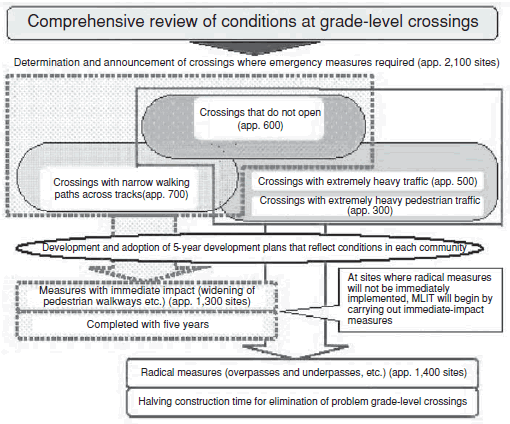
Outline of policy flow
Comprehensive Safety Measures for Public Transportation
In recent days, public transportation has suffered a series of major accidents and safety-related setbacks, including the derailment accident on the JR West Fukuchiyama Line in April 2005 and problems in the airline industry caused by human error and by parts and mechanical malfunctioning. Many are pointing their fingers at a background of human errors, such as an inadequate commitment among senior managers to safety first, insufficient communication and information sharing between management and operational personnel, and between different divisions. Eliminating these problems and restoring the public's trust in public transportation has become an urgent issue.
Consequently, in June 2005, MLIT established the Committee to Evaluate Measures for the Prevention of Accidents Caused by Human Error in Public Transportation (chairperson: Administrative Vice-Minister, MLIT). This committee accepted testimony from outside experts and reviewed examples of efforts by industry to come up with comprehensive and effective measures against human error in public transportation systems.
In addition to implementing sector-specific safety measures for automobiles, railways, marine vessels and airlines, MLIT is implementing the following measures that cut across industry lines.
(1) Building safety management capabilities; sustaining safety management effortsMLIT is seeking to ensure transportation safety in land, maritime and air systems by imbuing the organizations of carriers and other providers with a sense of the importance of safety, and by helping to create corporate cultures that understand and effectively implement transportation safety measures. MLIT has mandated that all companies involved in the respective areas of transportation (automobiles, railways, marine vessels and airlines) prepare safety management regulations that detail operational policies relating to transportation safety. MLIT has required that these regulations also describe organizational arrangements and methods of communication on safety-related issues in each division, stipulate the implementation of internal audits, and provide for the continual review and improvement of operational practices. MLIT has also made it obligatory for each company to appoint a manager responsible for administering and controlling safety. MLIT is also encouraging companies to take the initiative to review and improve operational practices in order to ensure top leadership's involvement in assuring the safety of transportation. In this way, MLIT will foster the creation of safety management systems that involve everyone from top management to operational personnel working as a team. In addition, MLIT will introduce a Management Safety Evaluation System by which the national government monitors top management's involvement in safety management.
To carry out the above measures, MLIT drafted legislation to amend certain parts of existing law. This legislation resulted in the “Law to Amend the Railway Business Law to Enhance Transportation Safety,” which was passed in the 164th session of the Diet (law no. 19, 2006) and later promulgated.
MLIT is also preparing for the implementation of the Management Safety Evaluation System by developing guidelines that prescribe for all modes of transportation a common section within each company's safety management regulations dealing with the new system.
(2) Technological developments to prevent human errorAs transportation systems become more sophisticated and traffic on these systems grows increasingly congested, human-machine systems will continue to accelerate in sophistication and complexity.
In response, MLIT will encourage the adoption of new and sophisticated technological systems that help prevent human error. It will also actively support the development of technologies that alert train operators and others to potentially dangerous situations and that assist those managing transportation systems to monitor the status of the vehicles operating in their systems.
CHAPTER 2 MARITIME TRANSPORT
1 Maritime Accident Trends
1-1 Maritime accidents and rescues in 2005
(1) A total of 2,482 vessels were involved in maritime accidents, with 885 of them safely returning to port without assistance. Of the remaining 1,597 vessels, 1,357 needed rescuing. A total of 13,655 people were aboard vessels involved in accidents. Vessels requiring no assistance carried 8,293, while 5,217 of the remaining 5,362 required rescue.
(2) There were 145 people who died or became missing in maritime accidents, and 131 people who died or became missing after falling overboard.
(3) Fishing vessels reported the largest percentage of total fatalities and missing persons involved in maritime accidents or falling overboard, 60% for the former and 63% for the latter.
Changes in Vessels, Fatalities and Missing People in Maritime Accidents
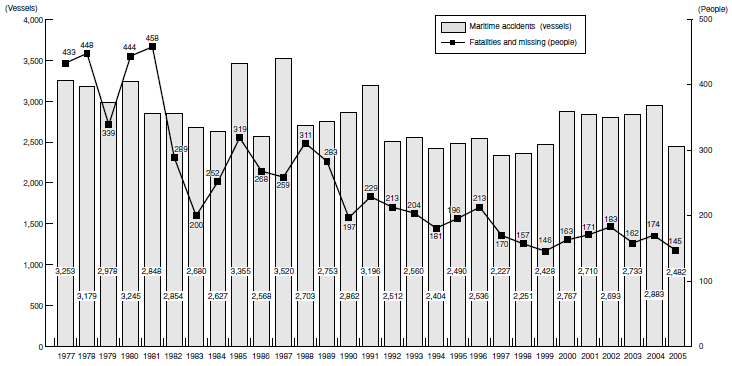
Notes: |
1. | Source: Japan Coast Guard |
|---|---|---|
| 2. | Figures for fatalities and missing people include those who, due to illness or other reasons, became unable to operate the vessel and died as it drifted. |
(1) A total of 985 pleasure boats were involved in maritime accidents, with 179 returning to port without assistance. Of the remaining 806, 727 required rescue.
(2) The number of pleasure boats involved in maritime accidents declined by 141 against the previous year, but pleasure boats accounted for 40% of all vessels in maritime accidents.
1 Pleasure boats is a general term denoting motor boats, yachts, water bikes and other small vessels used by individuals for leisure, sports or recreation.
Focus
Planned Maritime-Safety Initiatives
- From the Eighth Fundamental Traffic Safety Program -
1 Basic thinking
Because maritime accidents can have untold consequences for economic activity and the natural environment and lead to loss of precious life, the top priority is prevention. There is a need to enforce maritime safety measures aimed at securing the capability to mount prompt and appropriate search and rescue missions for crew members and others involved in maritime accidents and to aim for a society free of maritime accidents.
2 Objectives
- To prevent major maritime accidents resulting in obstruction of waterways in congested coastal waters and to reduce the incidence of such accidents to zero.
- To reduce the number of fatalities and missing persons resulting from maritime accidents and falling overboard to fewer than 220 per year by 2010.
3 Measures
(1) Perspective
There is a need to implement more effective measures by extending and bolstering the capability to mount rescues promptly and appropriately in coastal waters while taking various steps to prevent maritime accidents.
(2) Measures to be implemented
-
{1} Environment enhancement
Sea craft are growing in size and speed, uses of coastal seas are becoming more diverse and maritime traffic more complex. Against this background, the government is taking steps to improve information in the form of navigation charts and coastal pilots and communication utilizing IT while upgrading waterways, harbors, fishing ports and aids to navigation to ensure safe and smooth passage of sea craft and harbor safety.
-
{2} Maritime safety campaigns
In order to raise awareness not only among marine personnel but also marine-leisure fans and, ultimately, all citizens, the government will utilize every opportunity to draw attention to the importance of preventing maritime accidents. It will also implement more specific and effective safety-instruction programs adapted for the characteristics of each vessel type and the incidence and nature of accidents.
-
{3} Ensuring safe operation
The government aims to ensure safe operation of vessels by maintaining and improving the knowledge and skills of marine personnel and establishing a framework for promoting safe operation. It will also take action to oversee the qualifications of crew members of foreign ships calling into Japanese ports under the terms of international treaties. Furthermore, it will press for a total commitment to safety at all levels from top management to crew and will introduce a Safety Management Assessment program, which it will use to confirm the process.
-
{4} Maritime safety assurance
To ensure maritime safety, the government, acting under the terms of international treaties, will update safety-management standards related to vessel structure, facilities and marine transportation of dangerous substances and implement steps to supervise the structure and equipment of foreign vessels calling at Japanese ports. It will also take necessary measures to promote use of universal designs.
-
{5} Improving safety of small craft
In order to prevent accidents involving small craft, which account for the majority of maritime accidents, the government will improve the environment for safe operation and bolster its rescue capabilities in addition to raising safety consciousness among marine-leisure fans and commercial fishing-boat operators. It will also promote measures to prevent disasters involving elderly crew members and commercial fishing vessels resulting in casualties based on the Basic Plan concerning disaster prevention for seafarers and the Implementation Plan concerning disaster prevention for seafarers.
-
{6} Maintenance of maritime law and order
In addition to strengthening the regulation and policing of navigation in congested waterways as well as criminal activities likely to result in maritime accidents, the government will bolster regulation and policing during seasons of heavy marine-transportation activity and marine-leisure activity to maintain maritime law and order.
-
{7} Improving rescue and emergency services systems
The government will upgrade its rescue and emergency role to ensure rapid access to information about accidents, accurate predictions of current drifts, rapid mobilization of rescue teams and also to reinforce search and rescue capabilities. This will include shortening response times by upgrading mobile rescue capabilities utilizing the maneuverability and speed of helicopters and improving the operations of emergency life-saving technicians.
-
{8} Victim support
With respect to the obligation of vessel owners to compensate passengers and third parties injured in maritime accidents, the government will take action to notify relevant parties of expanded mandatory insurance requirements and boost the extent of insurance coverage while ensuring appropriate compensation taking into account changes in compensation levels.
Following major accidents, the Japan Coast Guard, police, medical institutions, local-government organizations and private victim-support organizations will cooperate to support victims.
-
{9} Improving capabilities in research and development and investigation and analysis The government will undertake comprehensive investigative studies related to maritime safety to identify the causes of maritime accidents and promptly reflect the findings in safety measures aimed at strengthening maritime safety.

Learning to put on life jackets
2 Current Maritime Traffic Safety Measures
2-1 Maritime environment enhancements
- Traffic safety enhancements
- In accordance with the Priority Plan for Social Infrastructure Development, projects were carried out to develop ports, harbors, and selected waterways, and to enhance the earthquake resistance of ports and harbors. Under the Long-term Development Plan for Fisheries Infrastructure (FY2002-2006), improvements were made to fishing-port and area facilities to promote greater safety for fishing vessels.
2-2 Maritime safety campaigns
- Safety programs based on study and analysis of measures to prevent a recurrence of maritime accidents
- A review of 2004 maritime accidents revealed that some 70% involved commercial fishing vessels or pleasure boats, and approximately 70% were the result of human error, such as failure to maintain adequate watch. To address this, the government sponsored programs in 2005 to encourage use of life jackets, enforce rules on maintaining watch and other measures to prevent maritime accidents based on recent accident trends and the characteristics of each type of vessel. These included lectures on accident prevention and visiting vessels to provide instruction.
2-3 Promotion of vessel safety
- Safety measures for pleasure boats
- Measures were implemented to enhance rescuing capabilities along coastal areas susceptible to maritime accidents, including more efficient use of patrol boats and aircraft, as well as initiatives to utilize fully the maneuverability, search and vertical-rescue capabilities of helicopters, especially at times and in areas where pleasure boats are active.
Focus
Ensuring Safe Operation of Vessels
-
I Between February and April 2006, there was a series of incidents involving a collision between a jetfoil traveling at high speed and some obstacle. One serious accident in April resulted in many injuries.
-
(1) On February 6, a jetfoil operated by JR Kyushu Jet Ferry struck an object thought to be a marine creature in an area north of Tsushima. On March 5, there was a similar incident in an area east of Tsushima and 14 passengers sustained slight injuries.
MLIT reacted to these incidents by issuing a notice to the company with instructions to:
- keep a sharper look-out
- collect and analyze information from eyewitnesses and take steps to reduce speed;
- enforce the wearing of seatbelts during high-speed navigation.
As the company was involved in two similar accidents shortly thereafter, MLIT again instructed all operators of similar vessels to enforce the points outlined in the above-stated notice.
-
(2) On April 9, a jetfoil operated by Kagoshima Shosen between Kagoshima, Ibusuki, Tanegashima and Yakushima, collided with an obstacle at the entrance to Kagoshima Bay, resulting in minor and serious injuries to 110 passengers.
MLIT responded to this incident by conducting emergency inspections of premises of all operators of similar vessels to instruct them to publicize and implement the points outlined in the above-stated notice.
-
(3) In view of the above developments and in the interests of ensuring the safety of ultra-high-speed vessels, MLIT set up on April 13 a committee comprised of relevant administrative bodies, experts, manufacturers and vessel operators to study comprehensive and effective measures to secure safer operation of ultra-high-speed vessels from both the perspective of the physical structure of vessels and their operation and management.
-
-
II On April 13, 2006, there was a serious accident involving a collision in dense fog between two cargo ships (the 6,182-ton Philippine-registered Eastern Challenger carrying a crew of 25 and the 498-ton Tsugaru-maru carrying a crew of 5), resulting in the sinking of the Eastern Challenger.
All crew members of the Eastern Challenger were rescued by a Japan Coast Guard patrol boat and by the Tsugaru-maru.
As there was discharge of fuel oil from the Eastern Challenger following its sinking, the vessel owners immediately implemented measures to control the discharged oil by contracting with private organizations, including the Maritime Disaster Prevention Center, an independent administrative agency.
The Japan Coast Guard mobilized patrol boats, aircraft and an oil-spillage control squad to survey the floating oil and control any discharged oil working in concert with the private organizations contracted by the vessel owners. Most of the discharged oil was dispersed and eliminated, but a portion washed up in Tateyama City, Chiba Prefecture. Accordingly, the head of the Third Regional Maritime Safety Headquarters issued a request to the governor of Chiba Prefecture and the mayor of Tateyama City to take remedial action based on the Japanese law for the Prevention of Pollution from Ships and Prevention of Marine Casualties (No. 136, 1970).
MLIT conducted a special audit of the operator of the Tsugaru-maru and on April 18 issued a safety order to the operator based on the Coastal Shipping Business Law (No. 151, 1952), instructing the owner to collect information about weather and hydrographic conditions and to comply with operational standards in the event of an accident.
CHAPTER 3 AIR TRANSPORT
1 Air Traffic Accident Trends
1-1 Air-traffic accidents in recent years
A total of 23 accidents (involving Japanese commercial aircraft anywhere in the world or foreign commercial aircraft in Japan) occurred in 2005, resulting in 16 fatalities and 18 injuries. In recent years, there have been only two or three accidents per year involving large aircraft, mainly as a result of air turbulence. Most accidents involved small aircraft.
1-2 Problems involving air-traffic safety in 2005
- Safety problems involving air carriers
- Since January 2005, there has been a noticeable increase in problems resulting from human error or aircraft defects among Japanese air carriers. Notably, the Japan Airline group has experienced a series of safety problems, including improper use of undercarriage components in a cargo carrier and violations of traffic-control instructions at New Chitose Airport and at Incheon International Airport in South Korea (on January 22 and March 11).
- Safety problems with air-traffic control
- On 16 August 2005, there was a problem of improper handling of flight plan clearance for departing aircraft between a pilot and air-traffic controller at Niigata Airport and a similar problem at Miyazaki Airport on September 23. On November 2, as a result of non-provision of a landing clearance to an arriving aircraft by air traffic control, the aircraft had to abort a landing and restart its approach at Osaka International Airport. All of these incidents involved problems with air-traffic control.
Focus
Recent Air-Traffic Safety Problems and Countermeasures
1. Safety problems involving air carriers
There have been no accidents resulting in passenger fatalities among Japanese air carriers since the crash of JAL Flight 123 at Mt. Osutaka in 1985. The few aircraft accidents per year that occur mainly involve air turbulence. However, since January 2005, there have been a series of safety problems resulting from human error or aircraft defects, although none has resulted in an aircraft accident.
Specifically, in the short interval up to the time the Japan Airline group received an order from MLIT to improve its operations on March 17, 2005, there was a series of problems, including improper use of undercarriage components in a cargo carrier and violations of traffic-control instructions at New Chitose Airport and at Incheon International Airport in South Korea. Since the start of 2006, there have also been incidents, including delays in performing inspections because of poor maintenance management.
Incidents have also been reported with other air carriers, including violation of air-traffic control directions, pilots following erroneous altimeter directions, and operation of aircraft beyond the deadline for performing repairs.
2. Actions taken by MLIT
-
(1) apan Airlines group
On March 17, 2005, MLIT issued an order to the carrier to improve its operations and on April 14, 2005, received a report of improvement measures adopted. Since then, MLIT has conducted a program of continuous on-the-spot inspections to monitor the implementation of improvement measures.
On January 9, 2006, MLIT reprimanded the Japan Airlines group, instructing it to prevent human error, and on March 22, ordering it to ensure compliance with maintenance-work requirements.
-
(2) Skymark Airlines
On June 15, 2005 MLIT reprimanded the carrier for not having appropriate personnel to perform maintenance and on March 14, 2006, for inappropriate control of maintenance operations including the operation of an aircraft beyond the deadline for performing repairs. MLIT also established a special audit team to strengthen supervision because of concerns about the management of maintenance and safety at the carrier, stationing the team at Haneda Airport from March 17 to conduct auditing activities. Based on the results, the director general of the Civil Aviation Bureau issued an advisory to the president of the carrier to improve business operations, urging the carrier to take immediate steps to establish a safety-management system and to improve its maintenance management.
-
(3) Other
In view of the series of problems involving airlines, MLIT significantly strengthened the surveillance and supervision of air carriers by introducing random on-the-spot inspections and establishing a dedicated audit department within the Civil Aviation Bureau.
MLIT revised the Aviation Law, based on the Law to Amend the Railway Business Law to Enhance Transportation Safety implemented on March 29, 2006, to bolster preventive safety measures by requiring air carriers to establish safety-management systems, mandating the reporting of developments that could impede safety in normal aircraft operations and reviewing safety measures and safety standards by collecting and analyzing safety data.
Focus
Planned Air-Traffic Safety Initiatives
- From the Eighth Fundamental Traffic Safety Program -
1 Basic thinking
To implement air-traffic safety measures progressively to reduce aircraft accidents and
to prevent safety problems that could lead to accidents.
2 Objective
To continue the record of zero fatal accidents among specified national air carriers2 that has held since 1986.
2 Specified national air carrier: national air carrier operating aircraft with a passenger capacity exceeding 100 persons or maximum take-off weight of 50,000kg.
3 Measures
(1) Perspective
There is an urgent need to restore the people's trust in the safety of air transport by halting the series of problems that can be regarded as predictors of accidents.
Problems of congestion and delays at airports and in the air are becoming more serious with the growing concentration of air traffic. Given forecasts of further increases in air-traffic volume going forward, there is an urgent need to establish safer and more efficient air-traffic systems in the air while expanding airport capacity, starting with extensions to Haneda Airport.
(2) Measures to be implemented
-
{1} Enhancement of air-traffic environment
In order to address growing air-transport volume while ensuring air-traffic safety, the government will take steps to install future air navigation systems and progressively upgrade airspace and en-route to enhance the level of air-traffic control utilizing these systems.
-
{2} Safe operation of aircraft
The government aims to ensure safe operation of aircraft by such actions as establishing a dedicated department to audit airlines and by switching to a preventive-safety approach instead of one that deals with problems after the fact. Furthermore, it will press for the creation of a safety-management apparatus involving all levels from top management to crew and will introduce a Safety Management Assessment program, which it will use to confirm the process as part of the effort to ensure the safe operation of aircraft.
-
{3} Ensuring aircraft safety
The government will ensure aircraft safety by pressing airlines to adopt safety measures such as upgrading technical standards, improving collection and processing of information, and improving inspection functions.
-
{4} Improving rescue and emergency services systems
The government will upgrade its rescue and emergency role to ensure a rapid and appropriate response to aircraft disasters and accidents and bolster collaboration among pertinent organizations.
-
{5} Victim support
The government will bolster support for victims seeking compensation and advance measures that recognize the emotional condition of victims. In cases of major accidents, the police, medical institutions, local-government organizations and private victim-support organizations will cooperate to support victims.
-
{6} Improving capabilities in research and development and investigation and analysis The government will carry out research and development on air-traffic safety and investigation and analysis to identify causes of aircraft accidents and promptly reflect the findings in safety measures aimed at strengthening air-traffic safety.
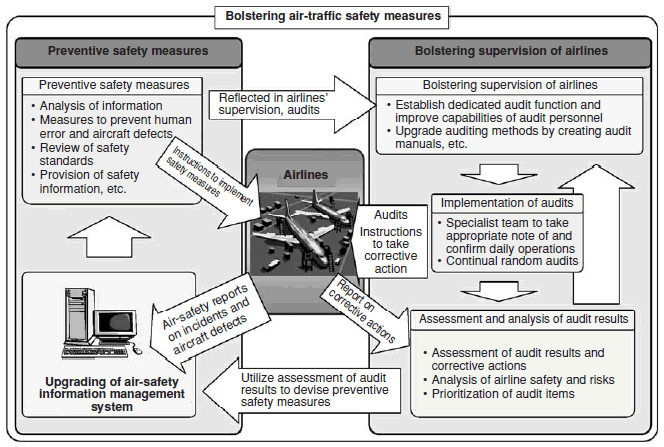
2 Current Air Traffic Safety Measures
2-1 Ensuring safe operation of aircraft
- Initiatives to ensure safety after abolition of regulations to balance supply and demand through guidance and supervision of air carriers and strengthening of air-safety systems
- Since January 2005, there has been a series of safety problems among Japanese air carriers caused by human error and aircraft defects. Notably, after the Japan Airline group experienced a series of safety problems, including improper use of undercarriage components in a cargo carrier and violations of traffic-control instructions at New Chitose Airport and at Incheon International Airport in South Korea, MLIT on March 17 issued an order to improve business operations to identify the cause of the problems and conduct comprehensive safety inspections, review the company's safety-assurance organization, and redouble efforts to raise the safety consciousness of employees. On April 14, MLIT received a report from the Japan Airlines group outlining remedial actions addressing common factors and reasons for the series of problems and measures to prevent a recurrence, including references to problems that had occurred since MLIT issued its order to improve business operations. MLIT has continued to perform on-the-spot inspections to monitor the implementation of improvement measures. Moreover, as there have also been safety problems among other air carriers, such as violation of air-traffic control directions and flights based on erroneous altimeter directions, MLIT has taken a serious view of the situation and has implemented air-transportation safety measures, including use of random inspections and strengthened surveillance and supervision of air carriers.
- Measures to deal with air-traffic control problems
- In light of not a small number of safety-related incidents involving air-traffic control, MLIT gave priority to preventive measures, including safety audits of air traffic control facilities.
2-2 Ensuring aircraft safety
- Improving maintenance and examination of aircraft
- In addition to specified examinations of carriers and regular safety inspections, MLIT has directed carriers to address ongoing air problems by identifying the causes of aircraft defects and preventing recurrences and has introduced random on-the-spot inspections in order to strengthen surveillance and supervision of air carriers.
PART II
TRAFFIC SAFETY MEASURES FOR IMPLEMENTATION
IN FY2006
CHAPTER 1 LAND TRANSPORT SAFETY
Section 1 Road Transport Safety
1 Road Environment Enhancements
Provision of walking space with priority on pedestrian safety
With the cooperation of local communities, the national government will promote traffic-safety measures focused on pedestrians by actively implementing initiatives to build and upgrade sidewalks along school roads, residential roads and major roads in urban areas.
-
(1) Sidewalks along school roads
To ensure the safety of young children commuting to elementary schools, kindergartens, day care centers, and children's cultural facilities, the government will advance an ambitious program for the development of sidewalks etc., along school roads.
-
(2) Traffic-safety measures for residential roads
Working in cooperation with prefectural public safety commissions and road management agencies, the government will implement areawide and comprehensive accident-prevention measures in the Safe Pedestrian Areas of major roads on the edge of residential areas and commercial areas where there is a high incidence of traffic accidents resulting in causalities. It will also implement a vigorous program of sidewalk building alongside residential roads outside of Safe Pedestrian Areas.
-
(3) Provision of barrier free and other walk spaces
In order to help seniors and disabled people lead independent, socially active lives, the government will pursue ambitious programs of sidewalk building in areas near train stations, public facilities, welfare facilities, hospitals and so on, basing their plans on universal design concepts and ensuring sufficient width and evenness.
2 Dissemination and Reinforcement of Traffic Safety Messages
Traffic safety education for the elderly
The government will introduce the “Participation, Experience, and Practice-based Project to Promote Safe Driving for Seniors,” which aims to promote regional traffic safety education for seniors by providing senior traffic instructors (Silver Leaders) with the necessary knowledge about traffic safety and improving their leadership skills. It will also implement the “Central Training Program for Silver Leaders” to improve Silver Leaders' ability to educate sub-leaders.
In addition, it will implement the “Traffic Safety Awareness Program for Seniors,” encompassing the “Cross-generation Sharing Project,” in which people from three generations gather to learn about traffic safety, and the “Seniors Home Visit Project,” in which traffic safety guidance is provided at home to seniors unable to attend traffic safety seminars.
Promotion of safe use of bicycles
One aim of this program will be to instill an understanding among cyclists that bicycles are a form of vehicle and that when using roads, they must comply with the rules applying to all vehicles and observe road manners.
To prevent traffic accidents involving cyclists as well as nuisance behavior by bicycles, the government will strengthen educational activities concerning the correct way to ride a bicycle with due regard for pedestrians and other vehicles.
Promoting wearing of rear seat belts
The government will promote the wearing of rear seatbelts as part of its program to foster understanding of the benefits of seatbelt usage and the correct method of wearing belts. It will actively utilize all opportunities and media to educate the public in cooperation with local public authorities and relevant agencies and organizations. In light of data concerning accidents in which people are thrown from cars, it will promote the wearing of seatbelts by rear-seated passengers on national expressways.
3 Ensuring Safe Driving
Developing better and more effective measures for elderly drivers
In order to prevent traffic accidents among elderly drivers, the government will utilize lecture programs and classes for elderly drivers at the time of license renewal to advance traffic-safety education, including making elderly drivers aware of situations in which elderly drivers become involved in traffic accidents as well as the changes that are occurring in their physical functioning. For elderly drivers, in particular, it will endeavor to improve the current situation by studying the addition of new physical-function tests and effective ways of enhancing drivers' awareness of the significance of the results.
The government will also study measures to improve the relevance of tests by conducting a detailed analysis of the circumstances surrounding traffic accidents involving seniors. It will also endeavor to identify drivers with suspected dementia and to take administrative action to cancel the licenses of persons thought likely to pose a hazard to safe driving.
4 Ensuring Vehicle Safety
Advancing vehicle safety
In the field of safety measures to prevent accidents from occurring, the government aims to take advantage of recent technology trends to expand and strengthen safety standards, promote the development and popularization of advanced safety vehicles (ASV), and to provide users with vehicle-assessment information. It will implement these steps in the interest of facilitating further improvements.
5 Improving Rescue and Emergency Services Systems
Advancing the training and deployment of emergency life-saving technicians and doctor cars
In order to improve pre-hospital care (emergency treatment at the scene of an emergency or during transportation to hospital), the government will promote the use of doctor cars (ambulances with a doctor aboard), train emergency life-saving technicians in order to achieve a more systematic deployment of such personnel at fire stations throughout the country and promote the use of lectures and practical training sessions to enable technicians to perform quickly and efficiently tracheal intubation and the administration of drugs, which are now possible under a broader definition of emergency treatment. It will also work to improve medical-control systems to ensure high-quality emergency treatment performed by emergency life-saving technicians and other emergency teams, under the guidance of a doctor.
Section 2 Railway Transport Safety
1 Railway Environment Enhancements
Installation of operational safety devices
Based on a plan for emergency improvements that was adopted in the wake of the JR West Fukuchiyama Line derailment, railway companies will be required to upgrade and improve safety equipment, including completion of the installation of ATS devices to prevent trains from traveling above allowable speeds on sharply curving sections of tracks, by FY2009. The government will also push for installation and upgrading of railway wireless and other communications equipment to enable prompt transmission of necessary information in emergencies, such as accidents or earthquakes.
2 Assuring the Safe Operations of Railways
Safety audits of railway companies
To ensure the safe operation of railways, the government will conduct safety audits of railway companies and provide appropriate guidance on the state of equipment and maintenance of rolling stock, train operation, training of crews and safety-management systems. It expects the company leadership itself to be cognizant of the situation at sites where safety may be an issue and, because a proper internal reporting system is essential to ensuring safe transportation of passengers, to utilize various opportunities to instruct and guide employees.
Furthermore, the government will press for the creation of a safety-management apparatus involving all levels from top management to crew and will introduce a Safety Management Assessment program, which it will use to confirm the process as part of the effort to ensure the safe operation of railways.
CHAPTER 2 MARITIME TRANSPORT SAFETY
1 Maritime Environment Enhancements
Upgrading of safety facilitiesIn accordance with the Priority Plan for Social Infrastructure Development, projects will be carried out in FY2006 to develop breakwaters, waterways, anchorages, and other infrastructure, in view of the growing size and speed of vessels. Action will also be taken to create emergency refuge harbors for vessels operating in coastal waters to avert imminent danger.
2 Ensuring Safe Operation of Vessels
Radical overhaul of pilot system
A bill was submitted to the 164th Diet session to revise partially the Pilotage Law relating to the training and employment of pilots, maritime-traffic safety assurance, and improvement of the efficiency and relevance of piloting operations (Bill to Revise Partially the Harbor Law to Strengthen Infrastructure for Maritime Distribution of Goods). This bill was enacted in May 2006 and outlines measures to be taken with the shift to the new system from April 2007.
3 Improvement of Safety Measures for Small Vessels
Increasing life-jacket usage
As a large percentage of fatalities or missing persons resulting from maritime accidents or falls from fishing boats or pleasure boats involve people who were not wearing life jackets, relevant ministries and agencies will collaborate with local governments and related organizations to promote vigorously and effectively a campaign to encourage people to protect themselves and to communicate the effectiveness of wearing a life jacket in order to maximize lifejacket use.
The authorities will also step up activities to counsel and police persons who violate regulations requiring the wearing of a lifejacket and will review regulations covering the wearing of lifejackets in order to increase lifejacket usage.
CHAPTER 3 AIR TRANSPORT SAFETY
1 Ensuring Safe Operation of Aircraft
Strengthening supervision of air carriersIn view of the growing complexity and diversity of airline corporate structures, the government will radically strengthen the existing on-the-spot inspection process by establishing a dedicated auditing organization. At the same time, it will improve the training of auditing personnel in order to ensure that audits are conducted in a professional and appropriate manner.
Additionally, it will press for the creation of a safety-management apparatus involving all levels from top management to crew and will introduce a Safety Management Assessment program, which it will use to confirm the process as part of the effort to ensure the safe operation of aircraft.
Switch to safety administration emphasizing preventionIn order to prevent accidents and major problems from occurring, the government will adopt safety-administration procedures to emphasize prevention, requiring airlines to report on events that hinder the normal and safe operation of aircraft by collecting and analyzing safety information, and will instruct airlines on safety measures and review safety standards. It will also review procedures for training airline employees and introduce an English certification system for pilots to improve the communication skills of pilots in order to prevent human error.
2 Ensuring Aircraft Safety
Improving aircraft maintenance and inspectionNew carriers are entering the market and the maintenance systems of carriers are becoming more diversified, with some carriers subcontracting the management of maintenance to other companies. In order to improve inspections in such an environment, the government will work to improve the quality of maintenance inspectors through training programs and revise the operating procedures for safety audits. It will also establish a dedicated auditing organization to strengthen the surveillance and supervision of carriers' maintenance systems and, at the same time, improve the maintenance-auditing function in order to address the increase in the number of new carriers.

